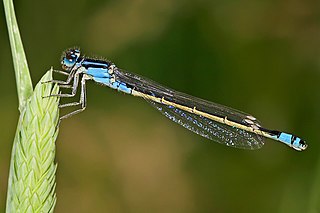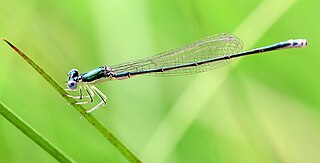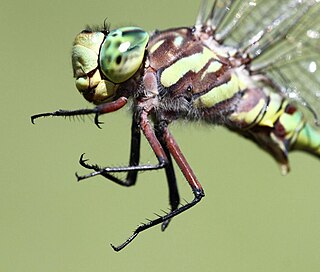
The blue-tailed damselfly or common bluetail is a damselfly, belonging to the family Coenagrionidae.

The azure damselfly is a species of damselfly found in most of Europe. It is notable for its distinctive black and blue colouring. They are commonly found around ponds and lakesides during the summer.

Ischnura senegalensis, also known variously as common bluetail, marsh bluetail, ubiquitous bluetail, African bluetail, and Senegal golden dartlet, is a widespread damselfly of the family Coenagrionidae. It is native from Africa, through the Middle East, to southern and eastern Asia.

Ischnura aurora, golden dartlet, also known as the aurora bluetail, is a species of damselfly in the family Coenagrionidae.

Ischnura is a genus of damselflies known as forktails in the family Coenagrionidae. Forktails are distributed worldwide, including various oceanic islands. The males have a forked projection at the tip of the abdomen which gives the group their common name.

The scarce blue-tailed damselfly or small bluetail is a member of the damselfly family Coenagrionidae.

The band-winged meadowhawk is a dragonfly of the genus Sympetrum belonging to the family Libellulidae.

Eastern forktail is a member of the damselfly family Coenagrionidae.

The sedge sprite is a species of damselfly in the family Coenagrionidae.

Austrolestes colensonis, commonly known as the blue damselfly, is a species of damselfly of the family Lestidae. It is endemic to New Zealand and can commonly be found throughout the country. It is New Zealand's largest damselfly. A. colensonis is usually seen close to fresh water between the months of October to May but is most abundant in January.

Pinheyschna subpupillata, the stream hawker, is a species of dragonfly in the family Aeshnidae.

Lestes elatus is a species of damselfly in the family Lestidae, the spreadwings. It is known commonly as the emerald spreadwing. It is native to India, Thailand and Sri Lanka.

Paracercion malayanum, Malay lillysquatter, is a species of damselfly in the family Coenagrionidae. It is known to occur in India, Sri Lanka, Nepal, Java, Philippines and Thailand.

Pseudagrion rubriceps, saffron-faced blue dart, is a species of damselfly in the family Coenagrionidae. It is found in many tropical Asian countries.

Anax indicus is a species of dragonfly in the family Aeshnidae. It is found in India, Nepal, Pakistan, Sri Lanka, and Thailand.
Palaemnema domina, the desert shadowdamsel, is a species of damselfly in the family Platystictidae. It is native to the extreme south of the United States and to Central America.
Neoneura amelia, commonly known as Amelia's threadtail, is a species of damselfly in the family Protoneuridae. It is native to the southern United States and Central America, its range extending from the southern tip of Texas to Panama.

Paracercion calamorum, the dusky lilysquatter, is a species of damselfly in the family Coenagrionidae. It has a range that extends from southern far-eastern Russia to Japan, and to India and Indonesia. The nominate subspecies P. c. calamorum is known from central and eastern China, Korea and Japan. The subspecies P. c. dyeri occurs in southern China, Hong Kong, Taiwan, Indonesia, India, Nepal, and Thailand.

Ischnura rubilio, western golden dartlet, is a species of damselfly in the family Coenagrionidae. It is found in Indian subcontinent and Iran.




















